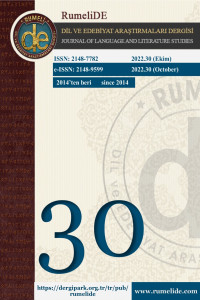Öz
Amerikalı oyun, roman, öykü ve biyografi yazarı Gertrude Stein, konvansiyonel tiyatro algısını kıran avangart tiyatro anlayışıyla yirminci yüzyılın ikinci yarısında alternatif ve deneysel tiyatronun esin kaynağı olan oyun yazarlarının başında gelmiştir. Gertrude Stein’ın oyunları resim, müzik, plastik sanatlar ve edebiyat gibi değişik disiplinlerden beslenen yönetmenler ve performans sanatçıları tarafından yorumlanarak sahneye aktarılmıştır. Gertrude Stein’ın yazınsal eserlerinin yanında yazdığı teorik metinlere baktığımızda karşımıza çıkan “Sürekli şimdiki zaman” kavramı ise Stein’ın yazınında alışılagelmiş tiyatroda seyirci zamanı ile oyunun zamanı arasındaki uyuşmazlıktan dolayı hissettiği “gerginliğe” karşı geliştirdiği bir strateji olarak karşımıza çıkmaktadır. Alışılagelmiş tiyatroya karşı hissettiği bu “rahatsızlık” aynı zamanda Gertrude Stein’ın tiyatro alanında yeni bir oyun tanımı getirmesine de yol açmıştır. Yazın faaliyetlerini üç dönem altında inceleyebileceğimiz Gertrude Stein, ilk dönemde yazdığı oyunlarını “olan şeylerin özü” olarak nitelemektedir. Alışılagelmiş tiyatroda karşımıza çıkan metinlerin aksine anladığımız anlamda bir hikâyeye odaklanmadan kaleme aldığı bu ilk dönem oyunlarında kullandığı “yıkıcı” dil aracılığıyla Stein, tiyatrodaki zaman uyuşmazlığına çözüm olabilecek türde eserler üretmiştir. Bu makale kapsamında Gertrude Stein’ın yazdığı ilk oyun olma özelliğini taşıyan Ne Oldu (1913) isimli oyunu üzerinden “sürekli şimdiki zaman” kullanımı incelenecek ve adı geçen kavram üzerinden yazarın geliştirmiş olduğu yazın stratejisi avangart oyun metinlerini anlamamıza yardımcı olacak bir dramaturjik yöntem olarak anlamlandırılmaya çalışılacaktır.
Anahtar Kelimeler
Amerikan Tiyatrosu Alternatif Tiyatro Gertrude Stein Deneysel Tiyatro Sürekli Şimdiki Zaman.
Kaynakça
- Bowers, Jane Palatini (1991). They Watch Me As They Watch This, Philadelphia, University Of Pennsylvania Press.
- Bowers, Jane Palatini (1993). Gertrude Stein, London, The Macmillan Press.
- Stein, Gertrude (1922). Geography and Plays, Boston, The Four Seas Press.
- Stein, Gertrude (1973). The Geographical History of America London, The John Hopkins University Press.
- Stein, Gertrude (1990) Look At Me Now and Here I Am- Writing and Lectures 1909-45, London, Penguin Group.
- Stein, Gertrude (1971). “Picasso,” Gertrude Stein a Primer for the Gradual Understanding of Gertrude Stein, Ed. by. Robert Bartlett Haas, Los Angelos, Black Sparrow Press, pp. 51-53.
- Diamond, Elin (1997). Unmaking of Mimesis Essays on Feminisim and Theater, London, Routledge.
- Meyer, Steven (2004). “Writing Pyschology Over: Gertrude Stein and William James” The Mind of Modernism: Medicine, Pychology and the Cultural Arts in Europe and America, 1880-1940, Ed. by. Mark S. Micale, California, Stanford University Press, pp. 251-274.
- Watson, Dan Cairns (2005). Gertrude Stein and The Essence of What Happens, Nashville, Vanderbilt University Press.
Öz
American playwright, novelist, story and biography writer Gertrude Stein, with her avant-garde perception destructing the theatre conventions, became one of the inspiring playwrights for the experimental theater in the twentieth century. Stein's plays were interpreted by directors and performance artists from various disciplines such as painting, music, plastic arts and literature. When we look at her theoretical texts alongside her literary works, the concept of "continuous present" emerges as a strategy developed by Stein against the "tension" she feels due to the “syncopation” between the time of the audience and the time of the play in the conventional theater. The "nervousness" she felt towards the conventional theater also led Gertrude Stein to introduce a new definition of play. Gertrude Stein, whose literary activities can be examined under three periods, describes her plays written in the first period as "the essence of what happened". Contrary to the texts in the conventional theater, Stein gave works that could solve the time conflict in the theater through the "subversive" language she used in these early plays. She wrote without focusing on a story. Within the scope of this article, the use of “continuous present” is to be examined through Stein's play What Happened (1913) and the literary strategy developed by her is to be interpreted as a dramaturgical method that will help us understand the avant-garde plays.
Anahtar Kelimeler
American Theater Alternative Theatre Gertrude Stein Experimental Theatre Continuous Present
Kaynakça
- Bowers, Jane Palatini (1991). They Watch Me As They Watch This, Philadelphia, University Of Pennsylvania Press.
- Bowers, Jane Palatini (1993). Gertrude Stein, London, The Macmillan Press.
- Stein, Gertrude (1922). Geography and Plays, Boston, The Four Seas Press.
- Stein, Gertrude (1973). The Geographical History of America London, The John Hopkins University Press.
- Stein, Gertrude (1990) Look At Me Now and Here I Am- Writing and Lectures 1909-45, London, Penguin Group.
- Stein, Gertrude (1971). “Picasso,” Gertrude Stein a Primer for the Gradual Understanding of Gertrude Stein, Ed. by. Robert Bartlett Haas, Los Angelos, Black Sparrow Press, pp. 51-53.
- Diamond, Elin (1997). Unmaking of Mimesis Essays on Feminisim and Theater, London, Routledge.
- Meyer, Steven (2004). “Writing Pyschology Over: Gertrude Stein and William James” The Mind of Modernism: Medicine, Pychology and the Cultural Arts in Europe and America, 1880-1940, Ed. by. Mark S. Micale, California, Stanford University Press, pp. 251-274.
- Watson, Dan Cairns (2005). Gertrude Stein and The Essence of What Happens, Nashville, Vanderbilt University Press.
Ayrıntılar
| Birincil Dil | İngilizce |
|---|---|
| Konular | Dilbilim |
| Bölüm | Dünya dilleri, kültürleri ve edebiyatları |
| Yazarlar | |
| Yayımlanma Tarihi | 21 Ekim 2022 |
| Yayımlandığı Sayı | Yıl 2022 Sayı: 30 |


